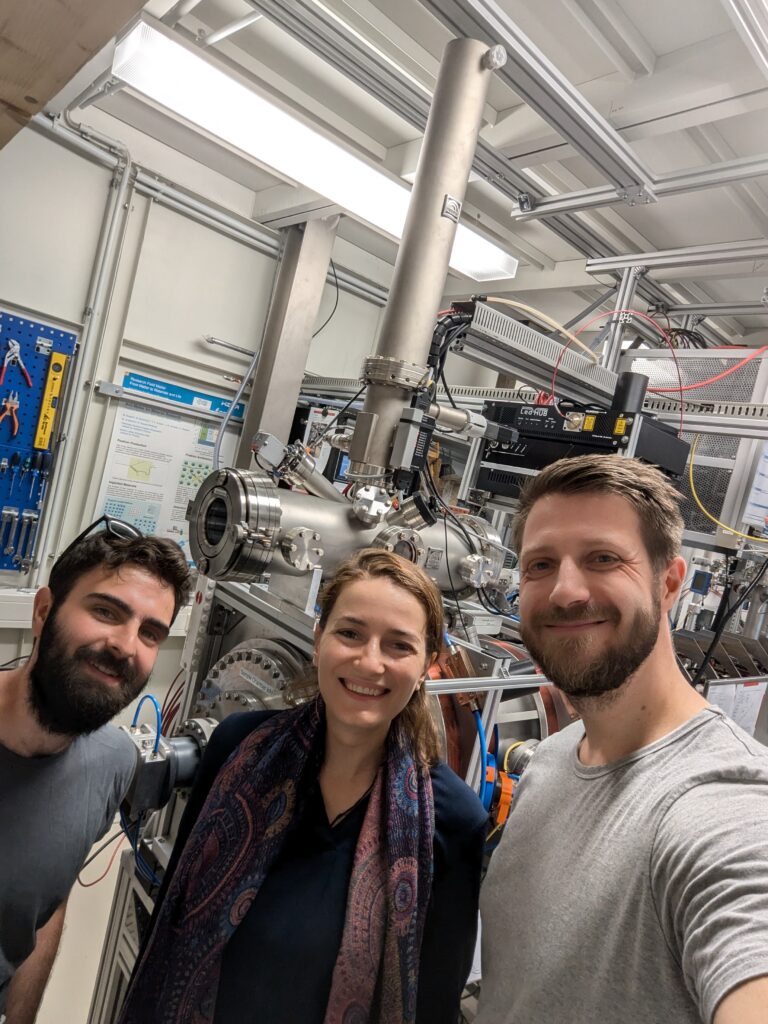We are excited to share the latest advancements in our research efforts in the context of the ReMade@ARI project.
𝐒𝐨𝐟𝐢𝐚 𝐏𝐚𝐧𝐭𝐨𝐮𝐬𝐚 and 𝐃𝐢𝐦𝐢𝐭𝐫𝐢𝐬 𝐏𝐚𝐩𝐚𝐝𝐚𝐤𝐢𝐬 under the supervision of 𝐊𝐨𝐧𝐬𝐭𝐚𝐧𝐭𝐢𝐧𝐚 𝐌𝐞𝐫𝐠𝐢𝐚 from the National Center for Scientific Research “Demokritos”, being part of the EUROfusion consortium, are conducting cutting-edge research which focused on understanding and mitigating radiation damage in materials. This is a crucial step towards realizing the potential of fusion energy — 𝘢 𝘤𝘭𝘦𝘢𝘯 𝘢𝘯𝘥 𝘴𝘶𝘴𝘵𝘢𝘪𝘯𝘢𝘣𝘭𝘦 𝘦𝘯𝘦𝘳𝘨𝘺 𝘴𝘰𝘶𝘳𝘤𝘦 𝘧𝘰𝘳 𝘵𝘩𝘦 𝘧𝘶𝘵𝘶𝘳𝘦.
Their research is centered on 𝐫𝐞𝐝𝐮𝐜𝐞𝐝 𝐚𝐜𝐭𝐢𝐯𝐚𝐭𝐢𝐨𝐧 𝐟𝐞𝐫𝐫𝐢𝐭𝐢𝐜/𝐦𝐚𝐫𝐭𝐞𝐧𝐬𝐢𝐭𝐢𝐜 (𝐑𝐀𝐅𝐌) 𝐬𝐭𝐞𝐞𝐥𝐬, which are poised to play a pivotal role as structural materials in future fusion reactors. These Fe-Cr based alloys, particularly those with around 10 at% Cr, offer excellent resistance to swelling and corrosion under irradiation, and exhibit minimal radiation-induced ductile to brittle transition temperature (DBTT) shifts. However, the extreme environment within a fusion reactor, characterized by intense neutron fluxes and high temperatures, presents significant challenges to these materials.

During their recent beamtime, allocated on August 2024 as part of the ReMade@ARI project, at the 𝐌𝐨𝐧𝐨𝐞𝐧𝐞𝐫𝐠𝐞𝐭𝐢𝐜 𝐏𝐨𝐬𝐢𝐭𝐫𝐨𝐧 𝐒𝐨𝐮𝐫𝐜𝐞 (𝐌𝐞𝐏𝐒) of the Helmholtz-Zentrum Dresden-Rossendorf (HZDR), they tackle these challenges by investigating the effects of radiation on RAFM steels using positron annihilation lifetime spectroscopy (PALS).
The group picture is showing (from left to right) Dimitris Papadakis, Sofia Pantousa and Eric Hirschmann during the beamtime at HZDR.
PALS enables to detect and to analyze microstructural changes and defects in the materials at an atomic level, providing unparalleled insights into radiation-induced damage mechanisms. By simulating the harsh conditions of a fusion reactor through controlled ion irradiation experiments conducted at the Ion Beam Center at HZDR, they could closely examine how these materials behave and evolve.
The data gathered from these experiments are invaluable, not only for enhancing our understanding of radiation effects but also for developing predictive models that will guide the creation of more resilient, neutron-resistant materials. These innovations are crucial for the success of future fusion reactors, which will rely on materials that can withstand prolonged exposure to radiation while maintaining their structural integrity.
Moreover, RAFM steels offer significant environmental benefits, aligning with the principles of the circular economy. These materials can be recycled and reused after a certain period, minimizing radioactive waste and reducing the overall environmental impact of fusion energy technology.
Special thanks to Maik Butterling, Maciej Oskar Liedke, and Eric Hirschmann for their invaluable support during the beamtime and the ongoing analysis of this promising data as well as to Miguel Sequeira for his support during the materials irradiation experiments.
That research work has received funding from the European Union as part of the Horizon Europe call HORIZON-INFRA-2021-SERV-01 under grant agreement number 101058414 and co-funding by the UK Research and Innovation (UKRI) under the UK government’s Horizon Europe funding guarantee (grant number 10039728) and by the Swiss State Secretariat for Education, Research and Innovation (SERI) under contract number 22.00187.
